St
Mary's Hospital
Highgate Hill, Highgate, N19
Medical
dates:
Medical
character:
Acute
In 1848 the Metropolitan Asylums
Board opened the Highgate Smallpox and Vaccination Hospital to replace
a smallpox hospital in St Pancras, which had to be demolished as the
Great Northern Railway needed the site for Kings Cross station.
The Hospital - one of the two isolation hospitals in London at that time (the other was the London Fever Hospital in Liverpool Road) - was intended to care for smallpox patients during the epidemic at that time. By 1867 it had 108 beds. Intended for paying patients, it was supported by voluntary contributions, but admitted paupers if beds were available. If continued as a smallpox hospital until 1896, when Clare Hall Hospital opened at South Mimms. The Metropolitan Asylums Board sold the 9 acre site to the Islington Guardians to use as a workhouse infirmary.
The Union built a large infirmary with 800 beds adjacent to the old smallpox hospital buildings. Officially opened in 1900 by the Duke and Duchess of York, the Highgate Hill Infirmary had a central administration and service block with ward blocks either side. The slope of the site meant that the northern blocks were 4 storeys high and the southern ones 3 storeys.
In 1914 it was renamed Islington Infirmary. By 1920 five linked blocks had been added to the south of the original building. Various out-buildings for laundry, stores and the mortuary were located to the rear of the old smallpox hospital, which itself had become the Nurses' Home. A tunnel linked the Nurses' Home to the ward blocks.
In 1930 administration for the Hospital was taken over by the LCC and it became St Mary's Hospital, part of the Archway Group. It had 836 beds and was far more modern than the other two hospitals in the Group - the Archway and the Highgate Hospitals.
By the time it became part of the NHS in 1948, it had merged with the Archway Hospital in Archway Road and the Highgate Hospital in Dartmouth Park Hill to form the Whittington Hospital.
In 1977 a new block opened, containing the Accident and Emergency, Out-Patients and Imaging Departments, together with pathology laboratories.
Further new buildings were added during the 1970s and by 1980 the site contained a 6-storey psychiatric wing. The Whittington Hospital at this time had 804 beds.
In 1992 the Great Northern building opened on the site. It contains modern wards and education facilities - a lecture theatre, seminar rooms - as well as a computer cluster room, office accommodation for the Deanery staff, a staff restaurant and a common sitting room for undergraduates.
Present status (March 2008)
Clinical services are now centred at the St Mary's Wing of the Whittington Hospital. The Hospital currently has 467 beds.
The new main entrance in Magdala Avenue opened recently.
The Hospital - one of the two isolation hospitals in London at that time (the other was the London Fever Hospital in Liverpool Road) - was intended to care for smallpox patients during the epidemic at that time. By 1867 it had 108 beds. Intended for paying patients, it was supported by voluntary contributions, but admitted paupers if beds were available. If continued as a smallpox hospital until 1896, when Clare Hall Hospital opened at South Mimms. The Metropolitan Asylums Board sold the 9 acre site to the Islington Guardians to use as a workhouse infirmary.
The Union built a large infirmary with 800 beds adjacent to the old smallpox hospital buildings. Officially opened in 1900 by the Duke and Duchess of York, the Highgate Hill Infirmary had a central administration and service block with ward blocks either side. The slope of the site meant that the northern blocks were 4 storeys high and the southern ones 3 storeys.
In 1914 it was renamed Islington Infirmary. By 1920 five linked blocks had been added to the south of the original building. Various out-buildings for laundry, stores and the mortuary were located to the rear of the old smallpox hospital, which itself had become the Nurses' Home. A tunnel linked the Nurses' Home to the ward blocks.
In 1930 administration for the Hospital was taken over by the LCC and it became St Mary's Hospital, part of the Archway Group. It had 836 beds and was far more modern than the other two hospitals in the Group - the Archway and the Highgate Hospitals.
By the time it became part of the NHS in 1948, it had merged with the Archway Hospital in Archway Road and the Highgate Hospital in Dartmouth Park Hill to form the Whittington Hospital.
In 1977 a new block opened, containing the Accident and Emergency, Out-Patients and Imaging Departments, together with pathology laboratories.
Further new buildings were added during the 1970s and by 1980 the site contained a 6-storey psychiatric wing. The Whittington Hospital at this time had 804 beds.
In 1992 the Great Northern building opened on the site. It contains modern wards and education facilities - a lecture theatre, seminar rooms - as well as a computer cluster room, office accommodation for the Deanery staff, a staff restaurant and a common sitting room for undergraduates.
Present status (March 2008)
Clinical services are now centred at the St Mary's Wing of the Whittington Hospital. The Hospital currently has 467 beds.
The new main entrance in Magdala Avenue opened recently.

The original Smallpox and Vaccination Hospital building

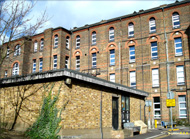
The Kenwood Wing, an old ward block, as seen from Darkmouth Park Road


The Female Receiving Ward, now the maternity wing
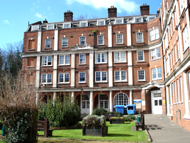
Another old ward block, still in use for physiotherapy, occupational therapy and social work
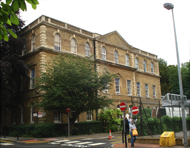

The former Nurses' Home is now called the Jenner Building and is used as office accommodation
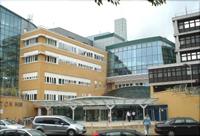
The new entrance to the Hospital in Magdala Avenue
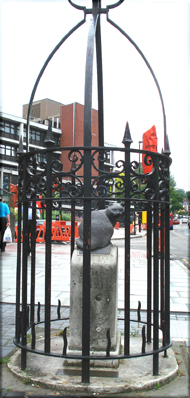
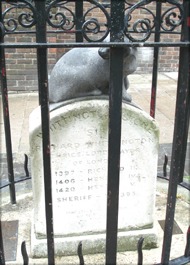
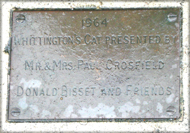
A small carving of a stone cat, with its head turned facing back to London, can be seen on Highgate Hill near the entrance to the Accident and Emergency Department.
http://archiseek.com
www.british-history.ac.uk
www.tipsimages.it (1)
www.tipsimages.it (2)
www.tipsimages.it (3)
www.whittington.nhs.uk
www.workhouses.org.uk
Return to home page